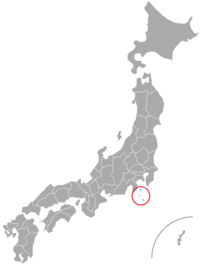| Northern Izu Archipelago dialects | |
|---|---|
| 北部伊豆諸島方言 | |
 Northern Izu Islands within Japan. | |
| Native to | Japan |
| Region | Izu Islands, Tokyo |
Japonic
| |
| Dialects |
|
| Language codes | |
| ISO 639-3 | – |
The Northern Izu Archipelago (or Islands) dialects (Japanese: 北部伊豆諸島方言 hokubu izu shoto hogen) are dialects of Japanese spoken on the inhabited islands north of Mikura-jima (Izu Ōshima, To-shima, Nii-jima, Shikine-jima, Kōzu-shima and Miyake-jima) in the Izu Archipelago, part of the Tokyo Metropolitan Area. The various dialects are classified as Eastern Japanese, and are most similar to the Izu dialect of mainland Honshū, but as islands have also developed unique traits which can vary considerably from island to island. On islands with large numbers of migrants from the mainland, such as To-shima, there is increasing standardisation of speech towards the common standard.
The following are general phonetic and grammatical features of the Northern Izu Archipelago dialects, with exceptions and individual variations listed in the island-specific sections.
The Northern Izu Archipelago dialects have a chūrin (中輪 ‘middle rim’) Tokyo standard pitch accent. The vowel sound /e/ is somewhat narrower than in traditional Tokyo dialects, and may lose its distinction with /i/ to become [i].[1][2] For example:
In some dialects, there is a /tu/ syllable. For example:
Northern Izu Archipelago dialects are classified under Eastern Japanese, with similar grammar structures to Shizuoka and West Kantō dialects, but also with a strong influence from the traditional Yokohama dialect. As aforementioned, however, the differences from island to island can be extreme. Below are some notable grammatical traits.